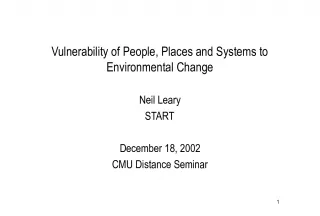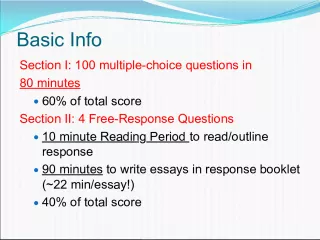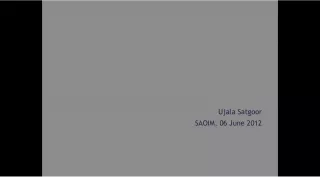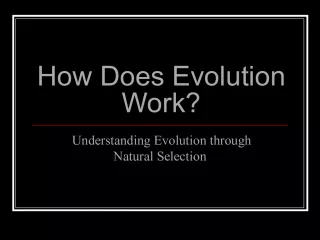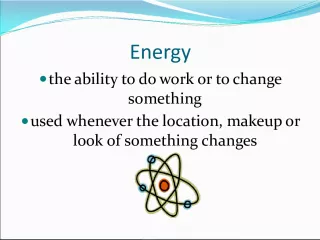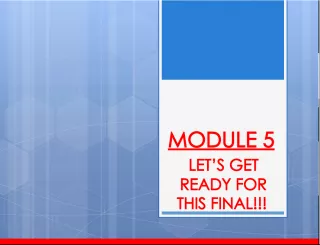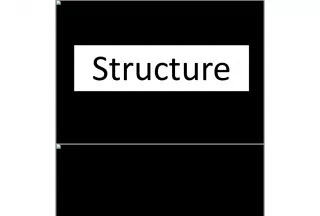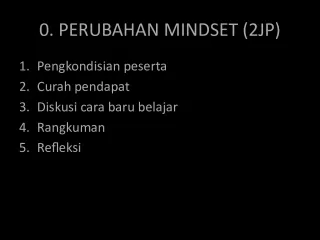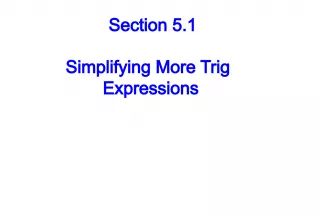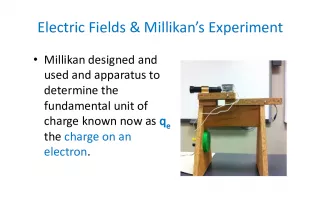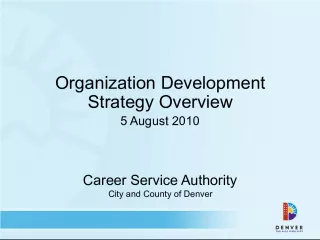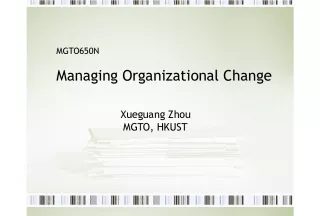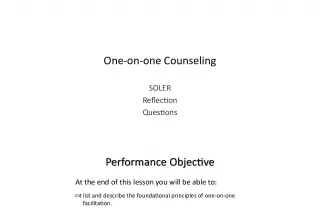Fundamental Questions for Change
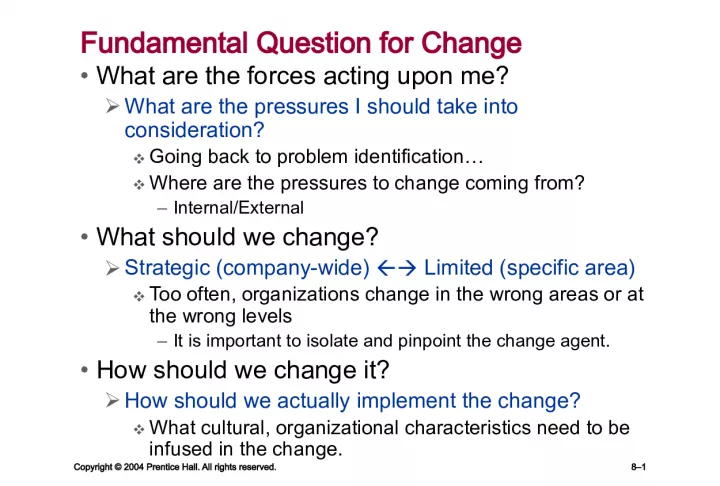

This text, published by Prentice Hall in 2004, discusses the important questions that organizations must consider when implementing changes. The text highlights the need to first identify the forces and pressures that are driving
- Uploaded on | 0 Views
-
 gavinhowell
gavinhowell
About Fundamental Questions for Change
PowerPoint presentation about 'Fundamental Questions for Change'. This presentation describes the topic on This text, published by Prentice Hall in 2004, discusses the important questions that organizations must consider when implementing changes. The text highlights the need to first identify the forces and pressures that are driving. The key topics included in this slideshow are . Download this presentation absolutely free.
Presentation Transcript
Slide1copyright © 2004 prentice hall. all rights reserved.8–1 Fundamental Question for Change • What are the forces acting upon me? What are the pressures I should take into consideration? Going back to problem identification… Where are the pressures to change coming from? – Internal/External • What should we change? Strategic (company-wide) Limited (specific area) Too often, organizations change in the wrong areas or at the wrong levels – It is important to isolate and pinpoint the change agent. • How should we change it? How should we actually implement the change? What cultural, organizational characteristics need to be infused in the change.
Slide2copyright © 2004 prentice hall. all rights reserved.8–2 Model for Planned Organizational Change FIGURE 8–1 Source: Adapted from Larry Short, “Planned Organizational Change,” MSU Business Topics , Autumn 1973, pp. 53–61 ed. Theodore Herbert, Organizational Behavior: Readings and Cases (New York: McMillan, 1976), p. 351.
Slide3copyright © 2004 prentice hall. all rights reserved.8–3 Strategic Change (1 of 4) • Strategic change Changing the fundamental strategy of the organization – While this may be necessary, it does pull at the fabric of the organization • Identity / Culture / Direction • Sources and Effects of Strategic Change Strategic changes are usually triggered by factors outside the company. – Usually a function of competitive posturing Strategic changes are often required for survival – Given that other change initiatives fail, it’s a must. Strategic changes implemented under crisis conditions are highly risky. – Given, they usually don’t follow organizational ideals
Slide4copyright © 2004 prentice hall. all rights reserved.8–4 Technological and Structural Change (2 and 3) • More specific in application Technological Change Changing the way the company creates and markets its products or services. – Production process, communication channels, workflow • This approach to change allows for major modification to specific areas of the organization • Without affecting others • Less resistance from the overall organization Structural Change Changing one or more aspects of the company’s organization structures. – Authority, Networks, Organizational Charts • High amounts of resistance – Reorganizing • Changing the firm’s organization chart and structural elements.
Slide5copyright © 2004 prentice hall. all rights reserved.8–5 Is a New Structure Really Required? FIGURE 8–2 Source: Adapted from Michael Goold and Andrew Campbell, “Do You Have a Well-Designed Organization?” Harvard Business Review , March 2002, p. 124. When you identify a problem with your design, first look for ways to fix it without substantially altering it. If that doesn’t work, you’ll have to make fundamental changes or even reject the design. Here’s a step-by-step process for resolving problems. When you identify a problem with your design, first look for ways to fix it without substantially altering it. If that doesn’t work, you’ll have to make fundamental changes or even reject the design. Here’s a step-by-step process for resolving problems. When you identify a problem with your design, first look for ways to fix it without substantially altering it. If that doesn’t work, you’ll have to make fundamental changes or even reject the design. Here’s a step-by-step process for resolving problems. When you identify a problem with your design, first look for ways to fix it without substantially altering it. If that doesn’t work, you’ll have to make fundamental changes or even reject the design. Here’s a step-by-step process for resolving problems.
Slide6copyright © 2004 prentice hall. all rights reserved.8–6 Is a New Structure Really Required? (cont’d) FIGURE 8–2b Source: Adapted from Michael Goold and Andrew Campbell, “Do You Have a Well-Designed Organization?” Harvard Business Review , March 2002, p. 124. When you identify a problem with your design, first look for ways to fix it without substantially altering it. If that doesn’t work, you’ll have to make fundamental changes or even reject the design. Here’s a step-by-step process for resolving problems. When you identify a problem with your design, first look for ways to fix it without substantially altering it. If that doesn’t work, you’ll have to make fundamental changes or even reject the design. Here’s a step-by-step process for resolving problems. When you identify a problem with your design, first look for ways to fix it without substantially altering it. If that doesn’t work, you’ll have to make fundamental changes or even reject the design. Here’s a step-by-step process for resolving problems. When you identify a problem with your design, first look for ways to fix it without substantially altering it. If that doesn’t work, you’ll have to make fundamental changes or even reject the design. Here’s a step-by-step process for resolving problems.
Slide7copyright © 2004 prentice hall. all rights reserved.8–7 Is Your Organization Well-Designed? • The market advantage test Does your design direct attention to competitive market sources? Volkswagen: 9 3 (Premium, Mass, Commercial) • The parenting advantage test Does your design allow the corporation to add value? GE: Spin-off or Conglomerate (Managerial competence) • The people test Does your design reflect strengths and weaknesses of personnel Pepsi Co. and Quaker (reacquisition of key personnel) • The feasibility test What problem would come with a new organizational design Classis example: As organizations grow / personnel type changes Small Innovative/Informal; Large Structured Roles
Slide8copyright © 2004 prentice hall. all rights reserved.8–8 Is Your Organization Well-Designed? • The specialist culture test Does the design facilitate and protect the core competencies of the organization? 3M Keeping the innovation alive • The difficult-links test Does your design allow for the critical links between core functions? Networks, Teams, Modular vs. Line • The redundant-hierarchy test Are there too many management stops (Decision stops)? Red tape • The accountability test Are there proper controls (checks and balances) in place? Rewards, Monitoring • The flexibility test Does your formal design allow for change and adaptation Within the parameters of the organizational strategy
Slide9copyright © 2004 prentice hall. all rights reserved.8–9 People / Behavioral / Cultural Change (4 of 4) • One Constant Regardless of the change initiative used Any change taken forth by an organization is going to encounter differing levels of resistance. Whether you formally mean to alter the culture, or it is a byproduct of another change initiative. It is inherently important to monitor the – Culture • Attitudes • Values • Skills Many change initiatives fail because of inadequate understanding of consequences on culture So, how do we monitor the effect of change on culture? First understand what it is and what it needs to be…
Slide10copyright © 2004 prentice hall. all rights reserved.8–10 How to Read an Organization’s Culture Observe the physical surroundings. Dress, openness, placement Sit in on a team meeting. How employees treat each other Rank issues Listen to the language. What are the buzz words… Note to whom you are introduced and how they act. What are the dynamics of the relationships in the organization? Get the views of outsiders, including vendors, customers, and former employees. Incorporate the views of all the stakeholders Their input will lead to a better overall view of the culture
Slide11copyright © 2004 prentice hall. all rights reserved.8–11 Creating and Sustaining the Right Corporate Culture 1. Make it clear to your employees what you pay attention to, measure, and control. 1. Through rewards, control functions, etc. 2. React appropriately. 1. Act in accordance with what is important 3. Use “signs, symbols, stories, rites, and ceremonies.” 1. Initiatives that go beyond compliance 4. Deliberately role model, teach, and coach the values you want to emphasize. 1. Top management must reflect culture in action 5. Communicate your priorities by how you allocate rewards. 1. DJ PJ IJ 6. Make your HR procedures and criteria consistent. 1. Make sure all HR outputs fall in line with culture
Slide12copyright © 2004 prentice hall. all rights reserved.8–12 Why Do We Resist Change? “It is usually not technical aspects that bring about resistance, rather social consequences” • Level 1 Lack of information Honest disagreement over the facts concerning change. • Level 2 Personal and emotional fear of Loss of job Relationships Status. Personality traits Poor self-image Low tolerance for ambiguity and risk. Change creates competing commitments.
Slide13copyright © 2004 prentice hall. all rights reserved.8–13 Kurt Lewin’s Model of Change • Unfreezing Involves reducing the forces for the status quo Usually by presenting a provocative problem or event to get people to recognize the need for change and to search for new solutions. – Participative decision making, Crisis • Moving Using techniques and actually altering the Behaviors, values, and attitudes of the individuals in an organization. – Organizational change techniques • Refreezing Preventing a return to old ways by Instituting new systems and procedures that reinforce the new organizational changes. – Reinforcement of new ways
Slide14copyright © 2004 prentice hall. all rights reserved.8–14
Slide15copyright © 2004 prentice hall. all rights reserved.8–15 Business Process Reengineering • Business Reengineering The radical redesign of business processes to: Cut waste Improve cost, quality, and service Maximize the benefits of information technology Accomplished through Questioning how and why things are being done as they are.
Slide16copyright © 2004 prentice hall. all rights reserved.8–16 Nine Steps to Organizational Change 1. Create a Sense of Urgency 1. Crisis, Eliminate excess, set targets, create impetus 2. Decide What to Change 1. Choose from on of the four change initiatives 3. Create a Guiding Coalition and Mobilize Commitment 1. Very important 2. Guiding coalition of influential people 4. Develop and Communicate a Shared Vision 1. Simple, participative, repetitive vision for everyone 5. Empower Employees to Make the Change 1. Give those that jump on board the power to make the changes 6. Generate Short-Term Wins 1. Instrumentality Let employees see rewards for their change 7. Consolidate Gains and Produce More Change 1. Shoe increased productivity (Create Legitimacy) 8. Anchor the New Ways of Doing Things in the Company Culture 9. Monitor Progress and Adjust the Vision as Required
Slide17copyright © 2004 prentice hall. all rights reserved.8–17 FIGURE 8–5 Barriers to Empowerment Source: Reprinted by permission of Harvard Business School Press. From Leading Change by John P. Kotter. Boston, MA. 1996, p. 102. Copyright © 1996 by the President and Fellows of Harvard College, all rights reserved.
Slide18copyright © 2004 prentice hall. all rights reserved.8–18 Organizational Development • Organizational Development (OD) An approach to organizational change in which the employees themselves formulate the change that’s required and implement it , usually with the aid of a trained consultant. What are some of the fundamental principles in this approach: Goal setting Participative decision-making Empowerment Leadership
Slide19copyright © 2004 prentice hall. all rights reserved.8–19 OD Interventions • Human Process Interventions Aimed at enabling employees to develop a better understanding of their own and others’ behaviors for the purpose of improving that behavior such that the organization benefits. • Sensitivity Training (Laboratory or T-groups) Purpose is to increase participants’ insight into their own behavior and that of others by encouraging an open expression of feelings in a trainer-guided group.
Slide20copyright © 2004 prentice hall. all rights reserved.8–20 OD Interventions (cont’d) • Team Building The process of improving the effectiveness of a team through action research or other techniques. • Survey Research The process of collecting data from attitude surveys filled out by employees of an organization, then feeding the data back to workgroups to provide a basis for problem analysis and action planning.
Slide21copyright © 2004 prentice hall. all rights reserved.8–21 Technostructural Applications of OD • Formal Structure Change Program An intervention technique in which employees collect information on existing formal organizational structures and analyze it for the purpose of redesigning and implementing new organizational structures.
Slide22copyright © 2004 prentice hall. all rights reserved.8–22 Strategic Applications of OD • Strategic Intervention An OD application aimed at effecting a suitable fit among a firm’s strategy, structure, culture, and external environments. • Integrated Strategic Management An OD program to create or change a company’s strategy by: Analyzing the current strategy Choosing a desired strategy Designing a strategic change plan Implementing the new plan.
Slide23copyright © 2004 prentice hall. all rights reserved.8–23 FIGURE 8–7 Conflict Handling Styles Source: Source: Kenneth W. Thomas, “Organizational Conflict,” ed., Steven Kerr, Organizational Behavior (Columbus, OH: Grid Publishing, 1979), in Andrew DuBrin, Applying Psychology (Upper Saddle River, NJ: Prentice Hall, 2000), p. 223.
Slide24copyright © 2004 prentice hall. all rights reserved.8–24 Interpersonal Conflict Styles 1. Confrontation 1. Head-on confrontation 1. Works when there is structural control 2. Forcing 1. Can be effective given you have the legitimized power 1. Still, may not truly change others 3. Avoidance 1. Hardly ever works 1. Does allow for some problems to solve themselves 4. Process controlling 1. Controlling the process used to resolve the problem 5. Compromise / Collaboration 1. Requires mutual sacrifice and subordination 6. Accommodating 1. Subordinating to the other desires )stop-gap)
Slide25copyright © 2004 prentice hall. all rights reserved.8–25
